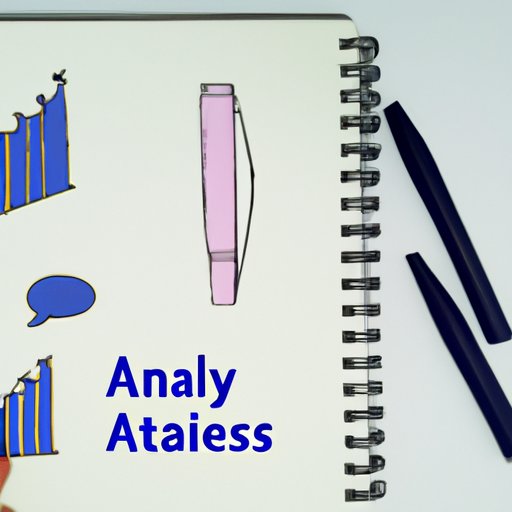
I. Introduction
Thematic Analysis is a popular qualitative research technique used to uncover hidden patterns and trends in data. It involves identifying, analyzing, and interpreting recurring concepts, patterns, and themes within data. Thematic Analysis is a flexible approach that can be used in various research settings, making it one of the most widely used qualitative analysis techniques.
This article provides a beginner’s guide to Thematic Analysis, including an overview of the key principles, the steps involved, its role in qualitative research, tips and tricks for data analysis, common misconceptions, and real-world examples of its application.
II. A Beginner’s Guide to Thematic Analysis: An Overview
Thematic Analysis is a flexible qualitative research technique used in various research settings. It involves identifying, analyzing, and interpreting recurring concepts, patterns, and themes within data.
The key concepts and principles of Thematic Analysis include:
- Identifying patterns and themes in data
- Coding and categorizing data into themes
- Collating, reviewing, and refining themes
- Interpreting and reporting the findings
Thematic Analysis can be useful for data analysis in qualitative research by providing a systematic way of identifying and analyzing patterns in data. It allows researchers to identify new and unexpected themes and patterns in data and can be used to answer a wide range of research questions.
Common misconceptions about Thematic Analysis include the belief that it is a rigid and formulaic technique with strict rules to follow. However, Thematic Analysis has flexible guidelines that can be adapted to different research contexts.
III. Understanding the Steps Involved in Thematic Analysis
Thematic Analysis involves several steps, including data collection, coding and theme identification, theme reviewing, and defining themes.
The steps involved in conducting Thematic Analysis include:
- Preparing and organizing the data
- Coding and categorizing data into themes
- Collating, reviewing, and refining themes
- Interpreting and reporting the findings
It is essential to manage and store data in Thematic Analysis software, which makes the process more manageable and ensures that you can trace the development of themes and the coding process.
IV. The Role of Thematic Analysis in Qualitative Research
Thematic Analysis fits into broader qualitative research methodologies by providing a systematic way of identifying and analyzing patterns in data. The significance of identifying themes and patterns in qualitative data is that it helps to answer research questions in a more intuitive and insightful way.
Thematic Analysis can be used to address a wide range of research questions and can inform decision-making in various contexts. For example, it can help answer questions related to health, social, environmental, and business issues.
V. Mastering Thematic Analysis: Tips and Tricks for Data Analysis
A few best practices for Thematic Analysis data analysis include managing the coding process and enhancing reliability and validity. One way to manage the coding process is to have a coding manual that outlines the codes and themes.
Reliability and validity are essential to ensure that the findings are accurate and consistent across different contexts. One way to enhance reliability is to use multiple coders to analyze the data. Another way to enhance validity is to ensure that the research process is transparent, and researchers are clear about the analytical choices they make.
To optimize efficiency in Thematic Analysis, it is essential to keep the focus on the research question, start analyzing the data as early as possible, and develop a coding template that can be reused for future analysis.
VI. Thematic Analysis 101: Common Misconceptions and How to Avoid Them
Common misconceptions around Thematic Analysis include the belief that it is a prescriptive method with strict rules to follow. To avoid errors in Thematic Analysis, it is crucial to develop a clear research question, have a clear and organized data collection process, and establish a clear coding structure.
Addressing potential issues with Thematic Analysis involves being transparent about the research process and allowing other researchers to engage with the research process and provide feedback.
VII. Comparing Thematic Analysis with Other Qualitative Analysis Techniques
Thematic Analysis differs from other qualitative analysis techniques in that it focuses on identifying and analyzing patterns and themes within data. Comparing Thematic Analysis with other qualitative analysis techniques involves assessing the suitability of each technique for the research question.
Thematic Analysis can be used alongside other qualitative analysis techniques, such as discourse analysis, to provide a more in-depth understanding of qualitative data.
VIII. Applying Thematic Analysis in Real-World Scenarios: Case Studies and Examples
Thematic Analysis has practical use cases in real-world research, including business, social, and environmental issues. Thematic Analysis can be used to uncover hidden patterns and trends in data, providing valuable insights that can inform decision-making.
For example, Thematic Analysis can be used to uncover patterns in social media data to understand consumer sentiment about a brand. It can also be used to analyze qualitative data from interviews to evaluate the impact of a social program on a community.
IX. Conclusion
Thematic Analysis is a widely used qualitative research technique that provides a systematic way of identifying and analyzing patterns and themes within data. This beginner’s guide has provided an overview of Thematic Analysis, step-by-step instructions, common misconceptions, tips and tricks, and real-world examples.
Thematic Analysis is a flexible and intuitive qualitative analysis technique that can be used in various research settings. We encourage readers to start using Thematic Analysis in their research work, as it can provide valuable insights that can inform decision-making and solve real-world problems.




